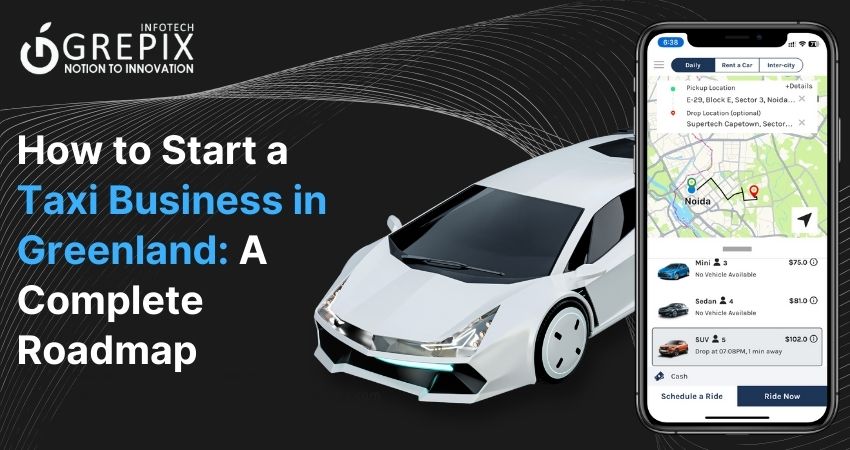How to Start a Taxi Business in Greenland: A Complete Roadmap
The guide emphasizes strategic hiring practices, proper driver training, and integrating dispatch systems with GPS and communication tools for efficient service. Effective marketing strategies include branding, building partnerships with local hotels and tour operators, and utilizing social media. As the taxi business grows, maintaining a strong reputation through excellent customer service and reviews becomes vital.
The blog also addresses the distinct challenges of operating in Greenland, such as harsh weather, limited road infrastructure, and seasonal demand fluctuations. It offers practical advice on how to navigate these hurdles while scaling sustainably. Whether you're a local entrepreneur or an investor looking to tap into Greenland's tourism surge, this roadmap provides the insights needed to start and grow a successful taxi business in one of the world's most remote locations.
Starting a taxi business in Greenland offers a unique opportunity to serve both local communities and the growing tourism market. This comprehensive guide walks you through each critical step from business model selection and financial planning to operational logistics and marketing. Entrepreneurs must choose between a traditional taxi service or a tech-enabled ride-sharing model while deciding whether to target locals, tourists, or both. Budgeting for vehicle acquisition, licensing, and winter-ready modifications is essential, especially in Greenland's icy climate.
1Market Analysis
Greenland's taxi market is driven by demand in major towns like Nuuk, Sisimiut, and Ilulissat, where cars, buses, and taxis are key for local and tourist transport. With Nuuk's population at around 20,000 Nuuk Population 2025, there's a significant customer base, especially during peak tourist seasons in summer.
2Legal and Regulatory Steps
Register your business in the Danish business register (CVR) at Choose a structure like ApS or A/S, ensure vehicle registration with the Greenland Police, and comply with tax laws. Driver licenses must be valid, though specific taxi regulations are unclear; consult local experts for clarity.
3Technology and Grepix Benefits
Grepix's software offers features like real-time GPS tracking, booking apps, and payment processing, which can simplify operations. It seems likely this can improve customer satisfaction and fleet management, making it easier to launch and scale your business.
4Detailed Analysis on Starting a Taxi Business in Greenland with Grepix
This comprehensive survey note provides an in-depth exploration of starting a taxi business in Greenland, focusing on the complete roadmap and the potential benefits of Grepix's taxi app software. It aims to guide new entrepreneurs through the process, highlighting market insights, legal requirements, operational strategies, and technological integration, with a particular emphasis on how Grepix can expedite the launch and enhance business efficiency.
1. Introduction and Market Context
Starting a taxi business in Greenland presents unique opportunities due to the country's sparse population and limited transportation infrastructure. With a total population of approximately 56,699 as of January 2024 List of cities and towns in Greenland, over 60% reside in major towns like Nuuk, Sisimiut, Ilulissat, Aasiaat, and Qaqortoq Grønlands Statistik. Nuuk, the capital, has a population of about 20,113 as of January 2025 Nuuk, making it a significant hub for taxi services. The demand is particularly high in urban areas for daily commutes, airport transfers, and tourist activities, with seasonal peaks in summer due to tourism.
Transportation in Greenland relies heavily on air and sea connections, with limited road networks. In larger towns, taxis are a popular means, as noted in travel guides How to get around in Greenland. Existing operators like Sisimiut Taxi and Nuuk Taxa indicate a market presence, suggesting room for competition and innovation.
2. Legal and Regulatory Framework
Establishing a business in Greenland requires registration in the Danish business register (CVR), for digital registration Setting up business in Greenland. Entrepreneurs can choose between ApS (minimum share capital DKK 40,000) or A/S (minimum DKK 400,000), with detailed management and liability rules outlined in the Companies Act How to set up a business in Greenland. For taxi businesses, vehicles must be registered with the Greenland Police, and import taxes apply if brought from abroad Car in Greenland.
Specific taxi regulations are not explicitly detailed in available sources, but general business compliance, including tax registration with Sulinal for employers Starting a business in Greenland, and ensuring drivers have valid licenses, is essential. Given the lack of specific taxi license information, consulting local authorities or legal experts is recommended to ensure compliance.
3. Business Planning and Setup
A robust business plan is critical, covering market analysis, service offerings (e.g., standard taxis, luxury vehicles), pricing strategies, and financial projections. Given Greenland's seasonal tourism, planning for cash flow fluctuations is vital. The business structure choice (ApS for simplicity, A/S for scalability) impacts liability and taxation, as noted in How to Register a Sole Proprietorship in Greenland.
Setting up involves registering via the Danish Business Authority's online system, ensuring all permits align with local zoning laws, and preparing for operational costs, which can range from $5,000 to $100,000 depending on scale The Cost Of Starting A Business In Greenland.
4. Fleet Management and Human Resources
Acquiring vehicles involves deciding between buying, leasing, or importing, with import taxes and shipping costs to consider Car in Greenland. Maintenance is crucial given Greenland's harsh climate, requiring partnerships with local mechanics. Insurance must cover liability for passengers and third parties, as per standard business practices.
Hiring drivers involves background checks and training on customer service and safe driving, especially given local road conditions. Labor laws, including working hours and wages, must comply with Greenland's regulations, as outlined in Starting a business in Greenland.
5. Technology Integration with Grepix
Grepix's taxi app software, as detailed in their offerings Security Features in Taxi Dispatch Software, includes a passenger app for bookings, a driver app for ride management, and an admin panel for operations. Key features include:
- Real-time GPS Tracking: Monitors driver locations for safety and efficiency
- Booking and Payment: Enables easy bookings and secure online payments
- Driver Management: Manages driver schedules and performance
- Customer Feedback: Collects ratings and reviews for service improvement
These features can streamline booking processes, improve customer satisfaction with real-time tracking, optimize fleet management, and enhance payment security. Grepix's Uber clone script, customizable for branding, offers a ready-to-launch solution, as seen in Ride Sharing App Development, making it ideal for new entrepreneurs in Greenland.
6. Marketing and Customer Service
Marketing strategies include leveraging social media, partnering with local businesses like hotels, and offering seasonal promotions to attract tourists. Customer service best practices involve training drivers to be courteous, implementing feedback systems via the app, and ensuring prompt responses to complaints, enhancing brand reputation.
7. Financial Management and Sustainability
Financial management requires accounting software for tracking revenues and expenses, managing cash flow to handle seasonal demand, and complying with Greenland's tax laws, including potential VAT and income tax Greenland customs and tax regulations. Sustainability involves considering eco-friendly vehicles to appeal to environmentally conscious customers and planning for expansion to other towns as demand grows.
5Planning Your Taxi Business
Starting a taxi business in Greenland requires more than just a few cars and drivers—it demands thoughtful planning, deep understanding of the environment, and a strong grasp of market needs. Greenland's vast icy landscape and remote towns mean transportation services must be tailored to unique geographical and weather conditions. Let's dive deep into the essential planning elements that form the foundation of a successful taxi operation in this Arctic nation.
1. Business Model
When launching your taxi business, your first critical decision is choosing the right business model. Should you go the traditional taxi service route or take the modern ride-sharing app approach? In Greenland, this choice depends on your target market, infrastructure, and customer behavior. The traditional taxi model remains a solid choice in many Greenlandic towns where smartphone usage might not be as high or where internet coverage can be patchy. This model relies on designated taxi stands, phone-in dispatch services, and word-of-mouth referrals. On the flip side, if you're aiming to cater to tech-savvy travelers or younger locals, launching a ride-sharing app might be a bold move that differentiates your brand. However, bear in mind the technological limitations and lower population density, which may impact user adoption.
You also need to determine your customer focus. Will you serve locals, tourists, or both? Locals offer the advantage of repeat business and steady demand. Tourists, however, bring a seasonal revenue boost, especially during peak summer months when cruise ships and tour groups flood towns like Nuuk and Ilulissat. Ideally, a hybrid approach allows you to tap into both segments offering reliable daily rides for residents while catering to the unique needs of visiting adventurers, such as airport transfers, guided drives, or scenic routes. Aligning your model with market needs will set the stage for sustainable growth.
2. Financial Planning
A rock-solid financial plan is your lifeline. Start by estimating your startup costs, which will include acquiring vehicles, licensing fees, insurance, initial maintenance, communication tools like radios or mobile apps, and branding elements like logo design. In Greenland, where importing vehicles can be expensive, and modifications like winter tires, heating systems, or 4WD conversions are necessary, your upfront investment may be higher than in more temperate regions. Expect to spend more on high-quality vehicles that can handle harsh terrains and unpredictable weather.
Once your startup costs are in place, dive into your pricing strategy and revenue projections. Taxi fares in Greenland can be higher than in other parts of the world due to limited competition and challenging operating conditions. Consider using a fare structure based on distance and time, with surge pricing during peak seasons or extreme weather conditions. Estimate your average daily earnings per car, and use this to project monthly and yearly revenues. Don't forget to factor in operating costs such as fuel, repairs, driver salaries, and taxes.
Next, consider how you'll fund your business. If you're self-financing, ensure you have enough to cover at least six months of operations. Otherwise, explore business loans through local banks or financial institutions. Grants and subsidies may be available through Greenlandic or Danish government programs supporting local entrepreneurship. You might even look into crowdfunding if your business model has a strong community angle or tourist focus. No matter your funding path, ensure it aligns with your long-term growth and cash flow strategies.
3. Operational Logistics
With your model and finances sorted, it's time to map out logistics because in Greenland, smooth operations don't come by chance. Start by deciding your initial fleet size. Most small-scale startups begin with two to three vehicles, especially in smaller towns. But don't just buy any car choose ones that thrive in Arctic conditions. Think rugged, reliable, and comfortable. Four-wheel drives are a must-have, particularly during winter when roads are slick with ice and snow. SUVs or vans with good ground clearance and heated interiors ensure both driver and passenger safety.
Maintenance is another critical factor. Greenland's extreme climate demands that vehicles are in top shape at all times. Cold weather wears down batteries faster, freezes fuel lines, and causes more frequent mechanical issues. Set up a routine maintenance schedule and partner with a local auto service provider who understands these challenges. Stock up on essentials like antifreeze, snow tires, and spare parts. Fuel, which can be costly due to importation, should also be managed strategically buy in bulk where possible and consider fuel-efficient vehicles without compromising on power.
Lastly, your operational logistics must include scheduling and dispatching. Are you running a 24/7 operation or covering specific hours? Will you have one central dispatch point or multiple stations? Develop a system that's flexible but efficient. Use basic GPS tracking or mobile apps to track vehicle availability and customer requests. Keep in mind that connectivity can be inconsistent in some areas, so having backup communication systems like two-way radios is highly recommended. The better your logistical groundwork, the smoother your daily operations will be.
6Setting Up Operations
Once the groundwork is laid and the plans are on paper, it's time to roll up your sleeves and get into the nitty-gritty of setting up operations. In Greenland, this phase requires careful attention to environmental, legal, and practical details to ensure smooth and sustainable functionality. From securing the right vehicles to hiring capable drivers and implementing technology, each step needs to be customized for Greenland's unique terrain and climate.
1. Acquiring Vehicles
Choosing the right vehicles isn't just about cost, it's about survival and service quality. Greenland's roads, while limited, are tough. Snow, ice, and rugged terrain are part of everyday driving conditions. Therefore, acquiring vehicles that can handle these extremes is non-negotiable. When deciding whether to buy or lease, consider your long-term vision and available capital. Buying vehicles gives you full control and potentially lower costs over time, but it requires a large upfront investment. Leasing may reduce initial expenditure and provide flexibility to upgrade your fleet as technology and needs evolve, though it might come with strict usage clauses or higher total costs in the long run.
Adaptation is another crucial aspect. Vehicles must be winter-ready, with high ground clearance, four-wheel drive, snow tires, and reliable heating systems. Depending on your target customers, consider different vehicle types standard sedans for short city trips, and vans or SUVs for tourist excursions or group transfers. Don't overlook the small but vital details either: durable windshield wipers, heated seats, roof racks for luggage, and emergency gear are essential in Greenland's unpredictable weather. Think of your vehicle not just as transportation, but as a mobile extension of your brand's reliability and safety promise.
2. Hiring Drivers
In Greenland, your drivers will make or break your business. They are the face of your brand, the local experts, and the ones navigating icy roads while keeping passengers safe. Hiring the right people starts with clear criteria look for experienced drivers familiar with Greenland's roads, and who have the necessary licenses and a clean driving record. But technical skills alone aren't enough. Your drivers should also be polite, punctual, and ideally bilingual (Greenlandic and Danish, with basic English for tourists). Customer service skills are paramount, especially when serving tourists unfamiliar with the region.
Training is a must. Even experienced drivers can benefit from refreshers on defensive driving, emergency protocols, and vehicle maintenance. Consider conducting regular training sessions, especially before winter, to prepare for the worst-case scenarios like road closures, blizzards, or breakdowns. Equip your drivers with tools like GPS, radios, emergency kits, and mobile phones. Make sure they know how to handle both routine and unexpected situations. You could also implement performance incentives to encourage safe and courteous driving, which will contribute to building a reputable brand in tight-knit communities.
Moreover, if you plan to scale, consider establishing a driver onboarding process. This can include written manuals, hands-on training, customer service roleplays, and probation periods. By investing in your drivers from the start, you're not just filling seats, you're building a trusted team that can carry your vision forward.
3. Technology and Dispatch
Even in Greenland, where technology adoption may not be on par with more urbanized nations, smart systems can give your taxi business a major edge. At the heart of your daily operations lies your dispatch system. This is how customers reach you, how you assign jobs, and how you monitor your fleet. For smaller operations, a manual dispatch center with a dedicated phone line might suffice. As you grow, though, consider incorporating more advanced systems a cloud-based dispatch dashboard, automated booking software, or even a basic app.
If developing a full-fledged mobile app isn't feasible right away, explore third-party platforms or low-cost solutions that allow GPS tracking, ride scheduling, and fare calculations. These features not only improve efficiency but also enhance customer experience. Remember, tourists especially will expect modern conveniences like cashless payment options, digital receipts, and live ride tracking. Even a simple website with online booking capabilities can set you apart.
Communication tools are another priority. Equip your vehicles with reliable GPS and two-way radios. Internet coverage can be patchy in some areas, so having offline communication methods ensures you're never fully out of touch. Internally, use software to track driver shifts, vehicle maintenance schedules, and fuel usage. A strong tech backbone can minimize errors, reduce wait times, and give you actionable insights to improve your business over time.
By blending traditional methods with practical technology, you create a taxi service that's efficient, responsive, and trustworthy even in one of the most remote places on Earth.
Conclusion
Starting a taxi business in Greenland is an ambitious yet rewarding venture, one that requires not just local insights and operational planning, but also a robust digital foundation. Whether you opt for a traditional fleet or a ride-sharing app model, technology plays a critical role in ensuring seamless bookings, dispatch, customer communication, and payment systems. That's where Grepix Infotech comes in.
As a leading taxi app development company, Grepix Infotech specializes in building high-performance, fully customizable taxi apps tailored to your specific business needs. From driver and passenger apps to admin dashboards and dispatch software, Grepix provides an all-in-one solution that helps streamline operations and enhance customer experiences. With years of expertise in the mobility sector, Grepix combines innovation, user-friendly design, and advanced backend technology to empower entrepreneurs launching transportation businesses even in the most remote and challenging locations like Greenland.
If you're serious about establishing a professional, efficient, and scalable taxi business, partnering with Grepix Infotech will give you a competitive edge right from day one. Let Grepix handle the tech so you can focus on growing your brand and serving your community.
FAQs
1. Is it profitable to start a taxi business in Greenland?
Yes, especially with the growing tourism industry and limited local transport options in towns
2. What type of vehicles are best for Greenland's roads?
4WD vehicles with winter tires and heating systems are ideal for snowy and icy terrains.
3. Do I need a special license to operate a taxi in Greenland?
Yes, you must register your business and obtain a taxi service license from local authorities.
4. How can I attract tourists to use my taxi service?
Partner with hotels and tour companies, use online ads, and promote your business through social media.
5. How many cars should I start with?
Starting with 2-3 vehicles is recommended to manage costs while meeting demand.
Looking out to start your own venture like Uber? Try out our HireMe Taxi Uber Clone, the easiest way to kick-start your taxi business.








